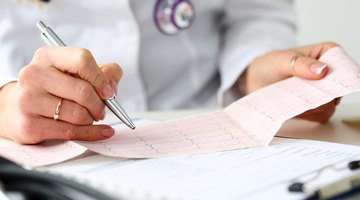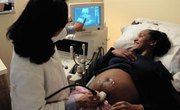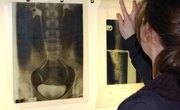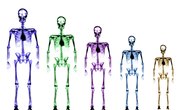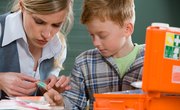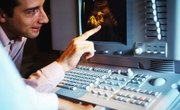Medical assistants are medically trained professionals who typically work in a doctor's office providing help to the physician, nurses and patients. Assisting with medical treatments, obtaining vital signs and performing tests are part of what medical assistants do during their shift. They are taught how to use equipment such as a heart monitor, blood pressure cuff and angiocatheter. An EKG is a test that allows a patient's heart rhythm to be seen and interpreted. A heart monitor or EKG machine is used to perform an EKG.
Learning When and Why to Perform an EKG
Part of a medical assistants training includes learning anatomy and physiology. Anatomy classes teach students the many parts and systems of the body. Physiology teaches how each of the parts and systems work. Understanding the parts of the heart and how they work together allows the medical assistant to understand the importance of an EKG test. This knowledge also helps a medical assistant know when and why to recommend EKG testing on patients who may benefit from the test such as those who come into the office with a history of cardiac problems.
Using an EKG Machine
Various types of EKG machines and heart monitors can perform EKGs. During a medical assistant's training, students are taught the parts of the machine (screen, lead wires, battery compartment), the different functions (recording EKG, printing rhythm strips, saving data) and the equipment used with the machine (EKG patches). Students will learn to apply the patches and leads to each patient, turn the machine on to the required settings needed to perform an EKG, how to print the results and save the data for a patient's medical records.
Preparing Patients for Testing
A medical assistant will be responsible for preparing the patient for EKG testing and is taught how to do so in training. Where on the body each lead should be placed, as well as what view of the cardiac rhythm is captured with the lead, is taught to future medical assistants during their program. Students are also instructed on how to prepare patients for an EKG. For example, to prepare a male patient for an EKG the medical assistant must first shave heavy amounts of hair from areas where the EKG patches are placed.
Recognizing Abnormal Rhythms
Students are taught during their training on EKGs, how to recognize various types of heart rhythms. Medical assistants must be able to look at the rhythm being captured by the EKG and determine if the rhythm is normal, known as normal sinus rhythm, or abnormal. Abnormal rhythms include atrial fibrillation (A-fib), ventricular tachycardia (V-tach) and bundle branch blocks. Medical assistants are taught when rhythms such as those which may indicate cardiac problems which may require immediate intervention and treatment to prevent permanent heart damage or death should be reported.
Cleaning and General Maintenance
How to care for and store EKG machines is also taught to medical assistant students during their training. The type of cleaning solution recommended for cleaning the screen, leads and dials will be discussed as well as the proper cleaning technique such as cleaning the lead wires from the point they attach to the machine down. General maintenance and troubleshooting may also be taught. Students learn how to replace and charge batteries, change EKG paper and how to hook the leads to the machine. Instructions on how and where to store the machine and its equipment may be discussed during class.
Related Articles
Writer Bio
Rachel Dennis has been a health-care provider for many years. Writing since 1994, she has publications both online and in print. Dennis uses her experience in health care to help break down the medical world into terms that are easy to understand.

